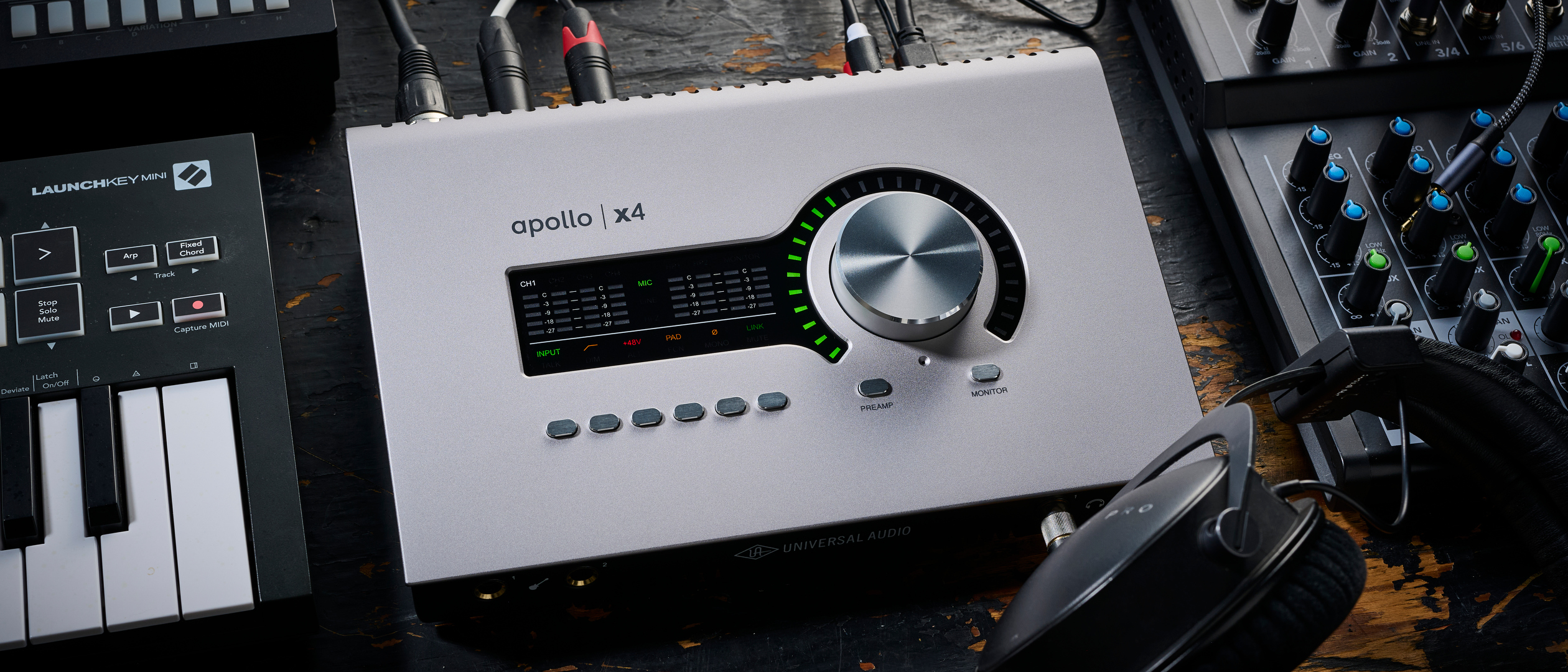MusicRadar Verdict
Powerful and intuitive, the Universal Audio Apollo x4 Gen 2 is a brilliant choice for engineers and producers who want a more professional home or travel rig. The studio-style workflow makes getting great sounds a breeze, and it’s got more than enough features to meet pretty much any demand.
Pros
- +
Incredibly powerful
- +
Compelling analogue-style workflow
- +
Excellent low-latency performance
- +
Lots of connectivity options
Cons
- -
Still no Thunderbolt cable included
MusicRadar's got your back
03/02/25 - This review was updated with our impressions of the Apollo Monitor Correction feature following its release.
Universal Audio Apollo x4 Gen 2 review: What is it?
Universal Audio’s Apollo series has been amongst the most highly rated audio interfaces for some time. I’ve seen many professional engineers use the smaller variants in their travel or home setups, but for some, they’ve been lagging behind other manufacturers in the more premium audio interface space. Having been initially released in 2012, it’s not unkind to say the Apollo series is getting a little long in the tooth.
Enter the Universal Audio Apollo x4 Gen 2, which aims to redress the balance back into UA's favour, putting them back at the top spot of the interface league table, at both the hobbyist end and the professional engineer part of the scale. Boasting a look reminiscent of the original units, improved D/A converters, and some brand-new usability features, I got hands-on before launch to put it through its paces.
Universal Audio Apollo x4 Gen 2 review: Features
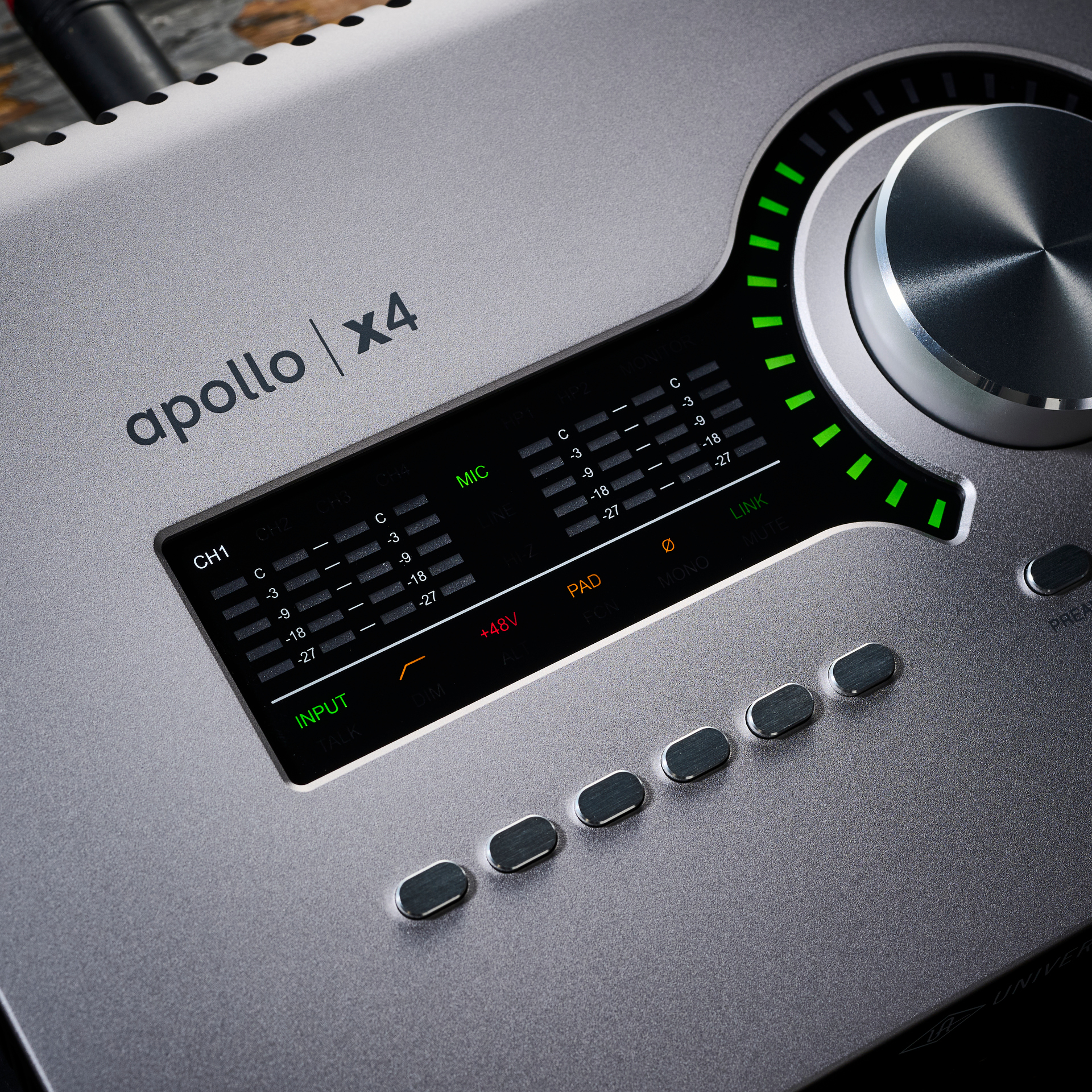
The new Apollo desktop interfaces are now available with two tiers of plugin bundles, with a third for x16 variants. The first level is called Essentials+ and features 32 plugins covering everything from preamps and compressors to reverb and delay, as well as a single instrument in the PolyMAX Polyphonic Synth. You also get Auto-Tune Realtime Access for perfecting your vocal takes and UA’s Luna DAW.
Upgrade to the Studio+ Edition and you’ll get 50 plugins to choose from as well as 6 software instruments. Auto-Tune Realtime X is included alongside Luna, and it’ll cost you around $300 RRP to make the jump from the Essentials version. Tiered plugin bundles with audio interfaces aren’t something I’ve really encountered before as typically you’ll get the same bundle with each interface, but it could be useful for those who already have a stacked plugin collection to cut back here.
One of the headline features is the inclusion of Apollo Monitor Correction, which allows you to import Sonarworks profiles to run on the interfaces DSP in real-time. Unfortunately, this wasn’t available for me to test at the time of writing, but as soon as it launches around November time, I’ll update this review accordingly. It’s an additional purchase with various tiers for new and existing SoundID users, and you’ll need to buy a Sonarworks licence, measurement mic, and Apollo Monitor Correction Add-on to get up and running.
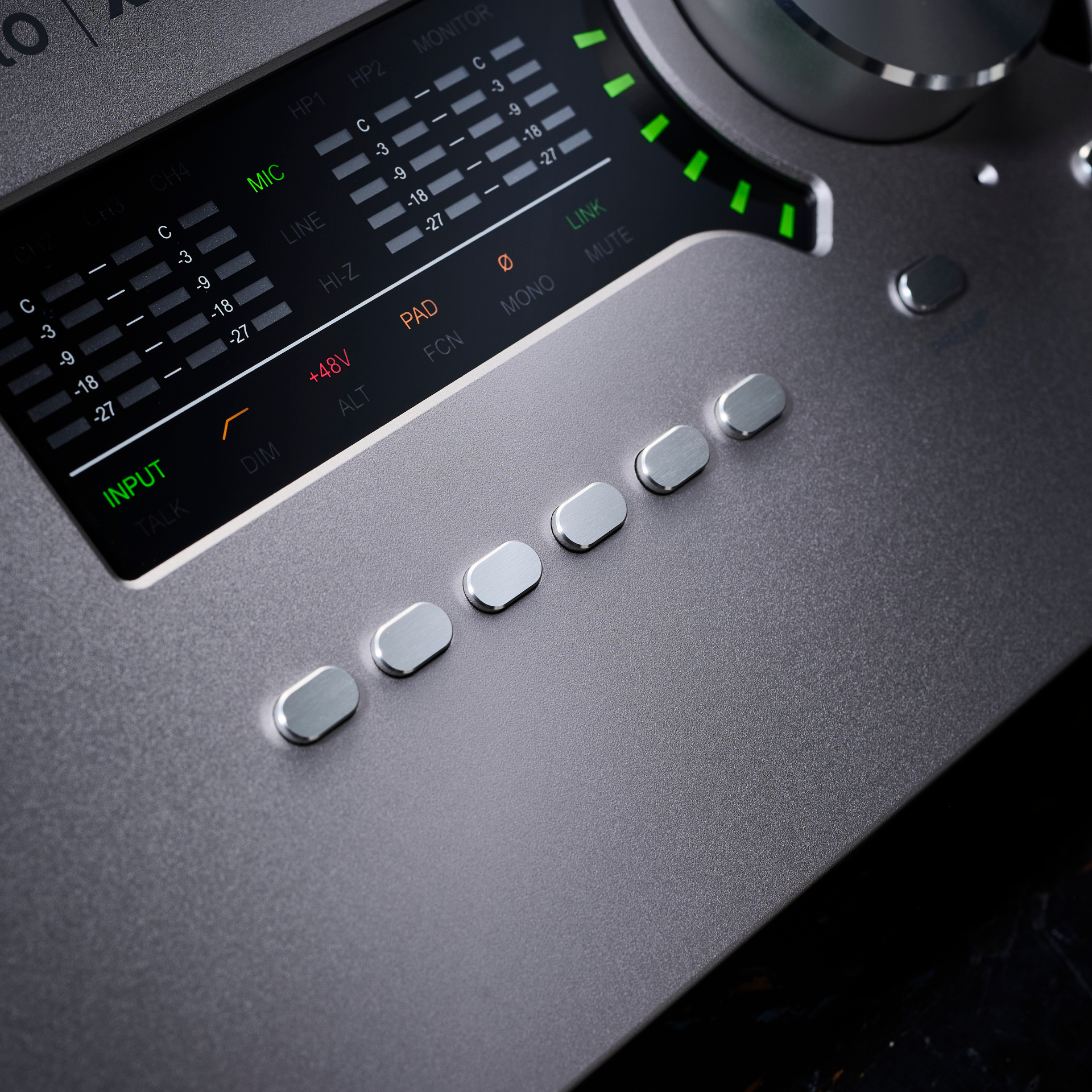
UA took us through a demonstration of it, and the gist is that you can easily open Sonarworks profiles within the interface to monitor stereo or multi-channel speaker arrays including a subwoofer-specific management system. It supports Calibration Target Modes so you can tune your own room or emulate other studio monitors to quickly check your mix will translate elsewhere. The process is deceptively simple, and this processing is always applied last in your signal chain to reduce latency.
Finally, there’s a brand new auto-gain feature which I’ve seen before on the Scarlett 4th Gen interfaces, allowing you to play your instrument during a brief ‘training’ window and automatically set a level. You can do this across all four input channels, making it great for getting perfect levels when using a multi-microphone setup.
Want all the hottest music and gear news, reviews, deals, features and more, direct to your inbox? Sign up here.
Universal Audio Apollo x4 Gen 2 review: Hardware
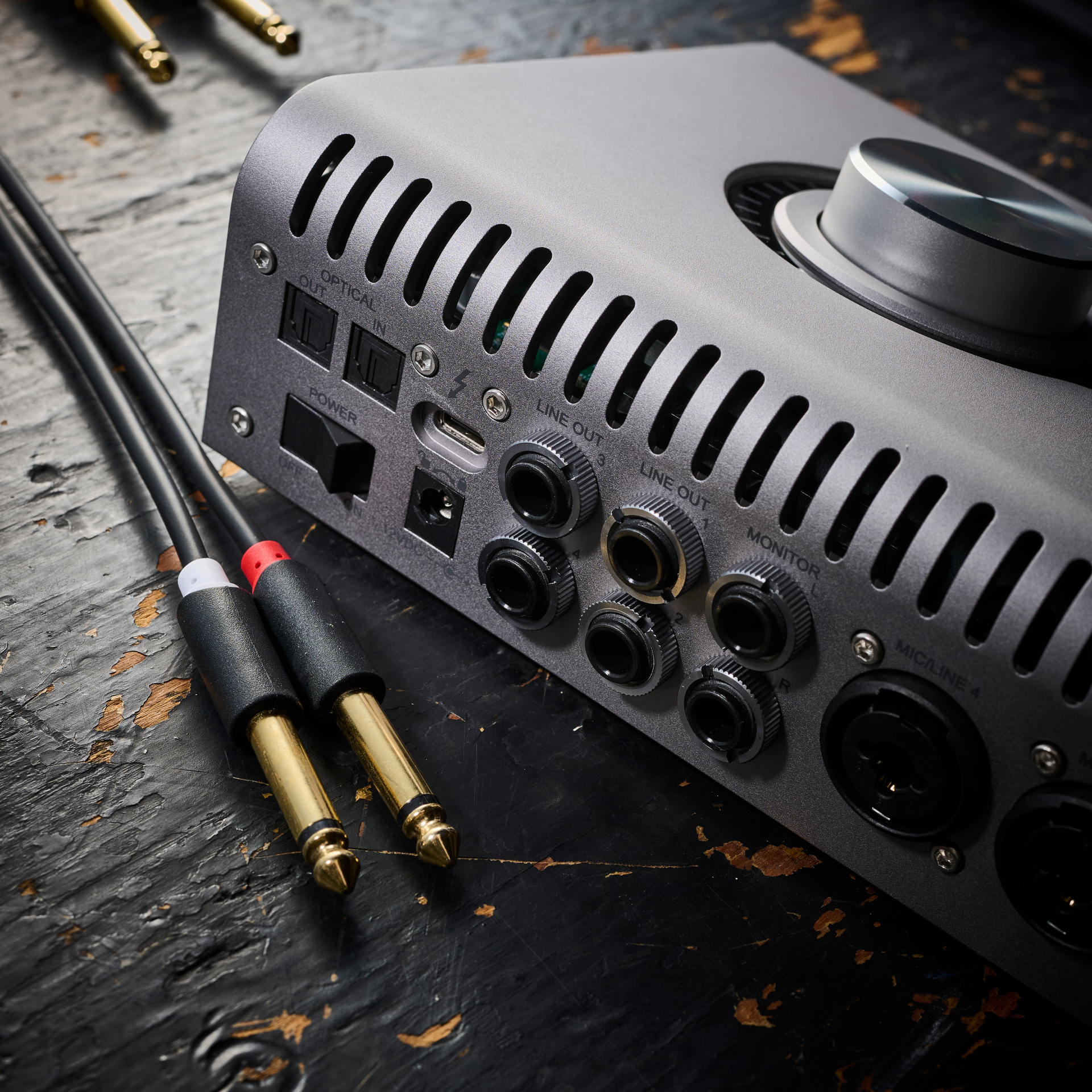
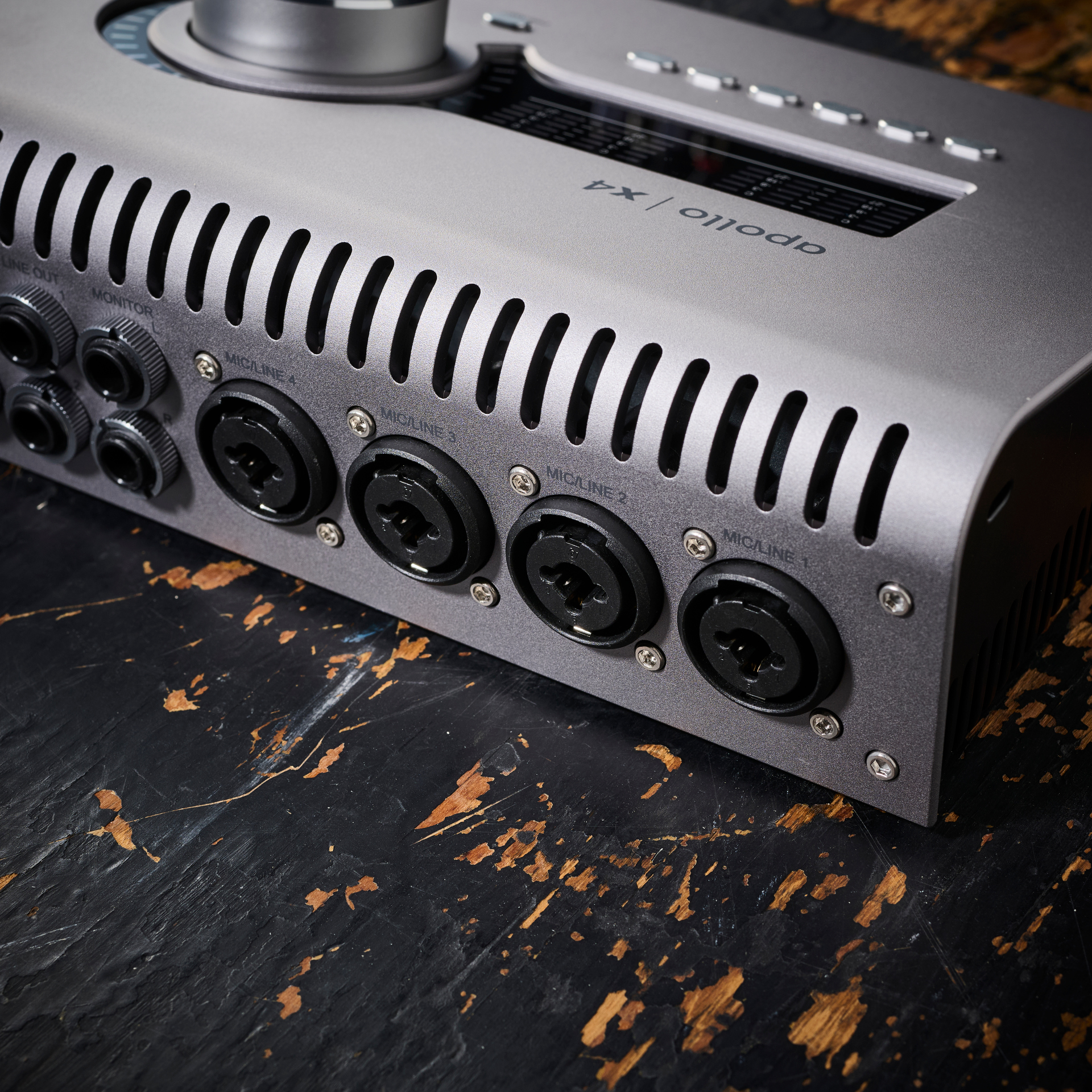
As you might guess from the name, the Apollo x4 has four combi inputs, each of which is sporting UA’s famed Unison preamps. Next on the back panel are two monitor outs, and four line outs, all sporting 1/4-inch inputs. For additional connectivity you’ve got a Thunderbolt port, and an Optical in and out that allows you to connect up to four additional UA interfaces should you wish to keep the desktop functionality when expanding to a rack mount setup.
On the front panel, you’ve got two Hi-Z inputs which replace channels 1 and 2 on the back when plugged in and two headphone outputs make it great for collaborating with other musicians and clients. You can also bypass the preamps on the desktop versions, allowing you to utilise the mastering grade line-ins straight into the upgraded converters.
Apollo’s converters have had an upgrade to reduce their noise and distortion levels, abbreviated as THN+D, and enhance their dynamic range, referred to as DNR. We’re talking very small numbers here with increases in the single digits as we near the theoretical limit of what digital audio is capable of, but if you’ve heard of the 90/10 rule you’ll know that it takes a lot of effort to get push those last few points of performance.
Universal Audio Apollo x4 Gen 2 review: Software
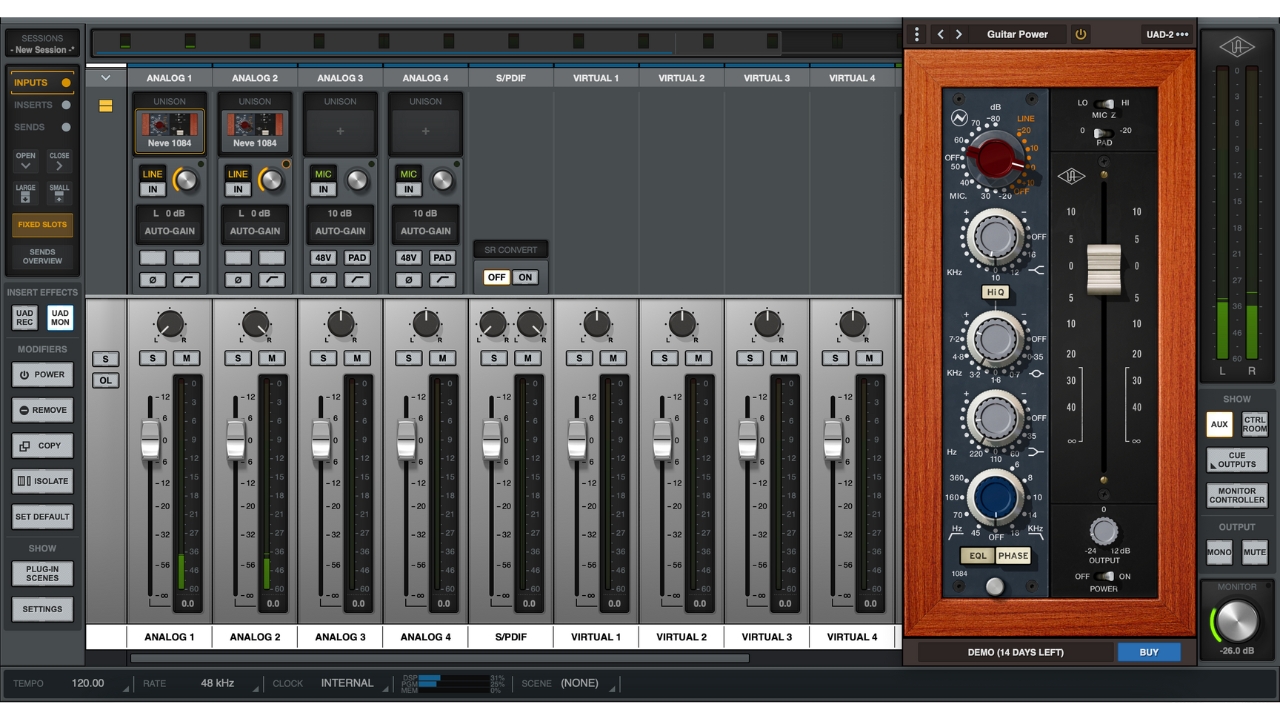
Getting the interface is handled via UA Connect nowadays, which offers a centre point for all your UA plugins, hardware, and the Luna DAW if you decide to use it. If you’ve already had a UA device installed on your machine then with a quick update of the UA console software and quicker firmware installation you’ll be up and running in no time. If you’re new to the UA ecosystem then the installation process is quite convoluted, so just be sure to read all the dialogue boxes that appear properly and you’ll save yourself quite a few headaches.
The UAD Console looks remarkably like the original, but there are some subtle changes afoot. First up is the new Auto-Gain function which sits just below the input gain in your chain. Clicking it brings up a dialogue box that asks you how long you want to play for, your listening threshold in dBFS, and your peak target in dBFS. Once you’ve played for the duration required it’ll suggest the correct level for your instrument and you can click done to proceed. It’s very similar to the feature I tested on the Scarlett 4th Gen interfaces, and although I’d imagine most engineers and producers will like control of setting their own levels, it’s a viable option if you’re in a hurry.
The workflow is exactly as I remember it from previous UA devices. Much like you would work at a desk you go from the top of the channel strip to the bottom, adding preamps, EQs, compressors, and anything else you like before you start recording into your DAW. There’s a lot of flexibility within the software, and the Console is really the heart of the Apollo x4, or any previous Apollo device for that matter.
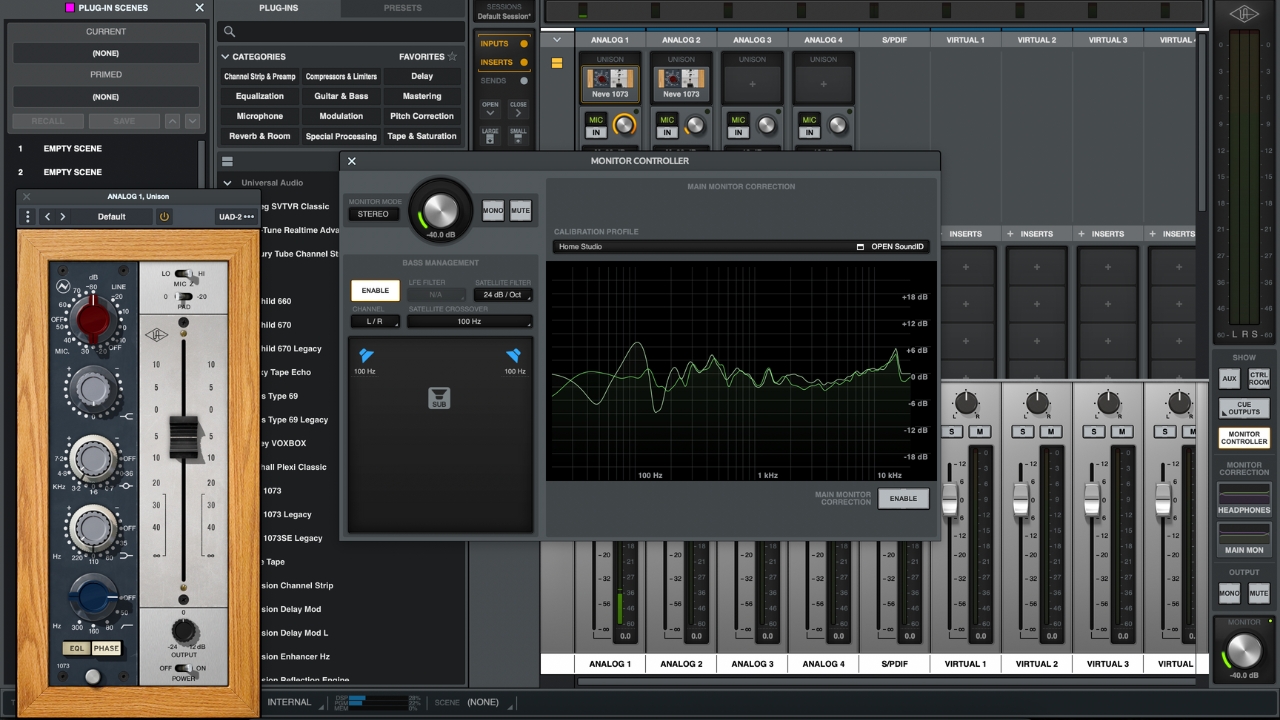
There's another new feature you'll notice in the bottom right of the UAD Console, which is integrated monitor and headphones correction. It requires a Sonarworks SoundID license and the accompanying measurement microphone to profile your room and studio monitors, as well as an additional Apollo Monitor Correction Add-on, so you'll need to spend more to gain access to it.
Measuring your room takes around 20 minutes, requiring you to first set up the measurement microphone in your listening position, then set it up close to each of your monitors, before finally placing it in different spots around your listening position in order for the software to learn your room. Whilst you're doing it your monitors play a clicking sound to determine the position before a sine sweep measures that particular point in your room.
With this built into the UAD Console software, you don't need to waste any processing power from your laptop or computer by running the plugin in your DAW session either. Instead, you can now run it straight from the Console, which gave me a very 'set and forget' kind of experience as once applied in the Console I didn't have to think about loading a plugin or applying it again afterward.
This is stuff that's done all the time in professional studios, and being able to do it for your own home studio is potentially a game changer. Listening to the differences between my HS5s pre-calibration versus afterward was an eye-opening experience for me, as was comparing them to the other references available in the software.
Universal Audio Apollo x4 Gen 2 review: Performance
I began my testing by plugging my Telecaster into the Hi-Z output on the front of the unit, and recording some basic DI guitar takes to see how it performed. Warming up the tone with a Neve 1084 preamp emulation and evening my playing out with the 1176 compressor plugin, the interface performed as expected, giving me a perfectly usable take to apply some HX Native amp simulation to.
With the sound of preamps being so subjective, I’m not going to say that the Universal Audio ones are better than anything else available at this price point. For me, it’s the ability to swap in and out various sounds for varying instruments that really takes the Apollo X4 above and beyond. Whether you’re going for a super simple Neve Preamp to just lightly boost and colour your tone, or you want to do full channel strip processing with the API Vision and compress, EQ, and gate your signal before it arrives into your DAW, the flexibility of the workflow makes it super engrossing process recording.
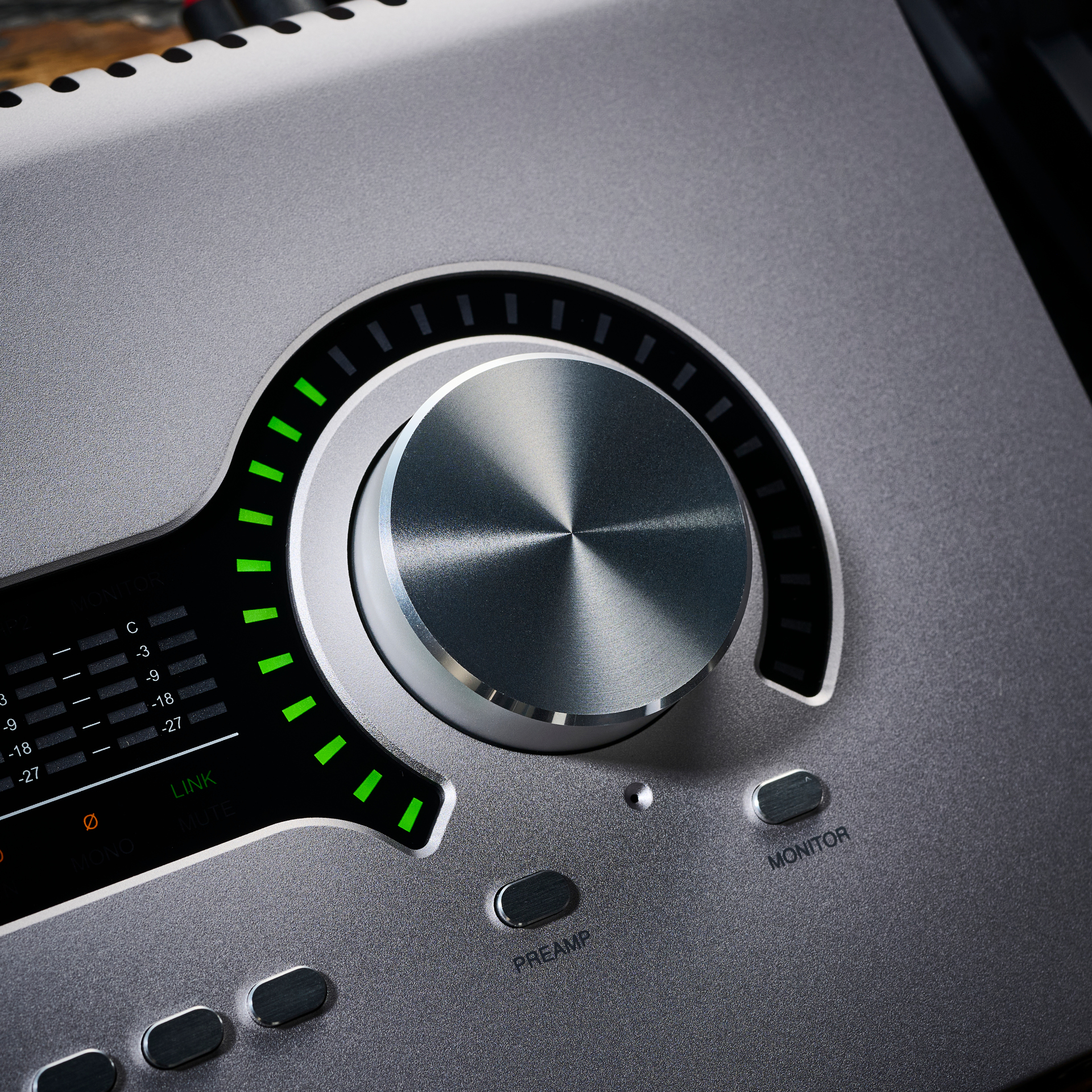
I found having a good selection of physical buttons on the front of the unit really useful, and as more music gear manufacturers start heading down the app-only route I’m glad that these have stayed from the previous iteration. Sometimes clicking away on your computer to bring up menus just isn’t as satisfying as turning a knob or pressing a button to perform an action, and the placement of these on the angled top of the x4 is super ergonomic.
Next up I tried stereo outs via a dual amp setup from the Neural DSP Quad Cortex I’m currently testing, applying separate processing to each channel and panning them hard left and right to create some humongous-sounding guitar takes. Even with separate preamps, compressors, and EQs doing some heavy lifting on the input, I didn’t come close to hitting the DSP limit of my unit, and the low latency performance was fantastic on my MacBook Air M1.
With a condenser microphone plugged in and my best impression of a topline again I found it similarly brilliant in its workflow approach. The huge array of presets built-in made it a breeze to dial in a great sound, applying preamps, compressors, and EQs to the chain that give you an excellent starting point to tweak from. Some even add reverbs and delays to the chain, although for me I’d rather use those just to help the performance and add my own later in the DAW.
Universal Audio Apollo x4 Gen 2 review: Final verdict
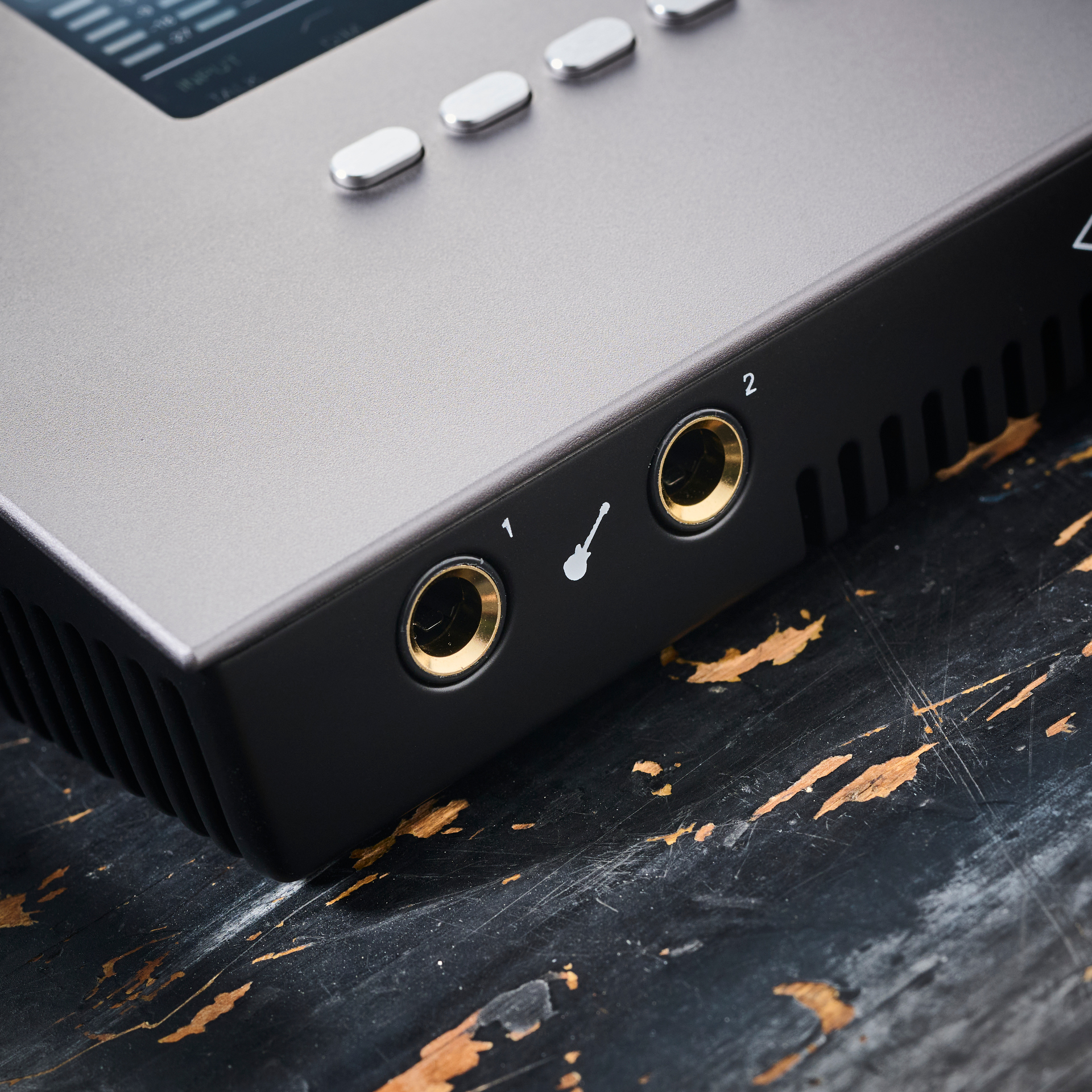
The performance upgrades with the Universal Audio Apollo x4 Gen 2 are evolutionary rather than revolutionary, but UA is building on a brilliant piece of kit that’s more than a match for the demands of the modern producer/engineer. The analogue style workflow of the UAD Console is still its best feature, and UA hasn’t done much to change this other than add a few usability features.
In my opinion, a four-input interface is a much better option for the producer/engineer who has experience already under their belt, allowing you to do more whilst still remaining relatively compact. So if you’re ready to make a step up from your beginner audio interface, the Apollo X4 might be pricey, but it’s totally worth the entry cost.
Universal Audio Apollo x4 Gen 2 review: Specs
- Price: $1999 with Essentials+, $2299 with Studio+
- Simultaneous I/O: 12 x 18
- A/D Resolution: 24-bit/192kHz
- Built In DSP/FX: UAD-2 Quad Core Processing, Realtime UAD Powered Plug-ins
- Number of Preamps: 4 x mic, 2 x instrument
- Phantom Power: Yes
- Analog Inputs: 4 x XLR-1/4" combo (mic/line), 2 x 1/4" (Hi-Z)
- Analog Outputs: 2 x 1/4" (monitor), 4 x 1/4" (line out)
- Digital Inputs: 1 x Optical Toslink (ADAT,S/PDIF)
- Headphones: 2 x 1/4" TRS
- Power Supply: 12V DC power supply (included)
- Contact: Universal Audio

Matt is a Junior Deals Writer here at MusicRadar. He regularly tests and reviews music gear with a focus on audio interfaces, studio headphones, studio monitors, and pretty much anything else recording-related. Matt worked in music retail for 5 years at Dawsons Music and Northwest Guitars and has written for various music sites including Guitar World, Guitar Player, Guitar.com, Ultimate Guitar, and Thomann’s t.blog. A regularly gigging guitarist with over 20 years of experience playing live and producing bands, he's also an alumnus of Spirit Studios, where he studied studio engineering and music production.
